Are you a coach, consultant, creative professional, or any type of freelancer? Then there’s no doubt you know this story…
One day you’re so swamped with client work you can’t even think about where you’re going to find your next client. Then when things slow down, you realize there’s no work lined up → PANIC! → then finally, a bunch of work comes in again → PHEW! → and the cycle starts all over again.
This is known as the “feast or famine cycle” and it happens when you don’t have a system for attracting clients while you’re busy serving the ones you have.
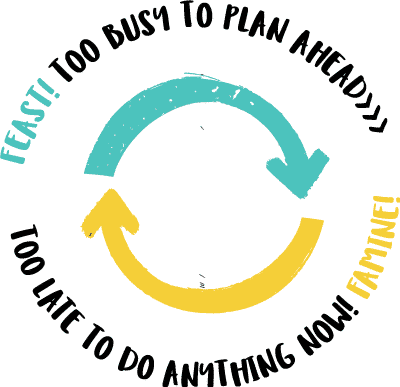
But just imagine being able to relax into your day-to-day work knowing that consistent interest in your work is always flowing toward you on autopilot.
In this post, we’re going to show you exactly how to get there! ?
What is a Sales Funnel for a Service Business?
While we usually talk about “sales funnels” in the context of selling products, the income and work consistency all service providers crave is exactly why you need them too. For you…
A sales funnel for service businesses is simply a series of steps that guides people from becoming aware of you to booking your services.
Even though we like to believe it’s a straight shot from discovering we exist to getting booked for a gig, you’ve probably already discovered first-hand that it just doesn’t work like that. It all comes down to timing.
A sales funnel gives people the information and nurturing they need and when they need it until they’re ready to hire you.
It keeps you top of mind, helps inspire trust, and can even position you as a go-to expert so when the time is right, it’s a no-brainer for them to take the next steps with you (there can be no substitute – it has to be YOU).
And because a funnel is largely automated, it works in the background for you 24/7/365 to generate leads and line up future work — even when you’re booked, busy, burned out, or heck, just want to take a week off. #treatyourself
Not only that, you can use your funnel to create financial leverage with passive income!
Offering a low-cost digital product to customers who are going through your funnel is a great way for service providers to offer a low-risk first step. It also provides an option for people who can’t afford your 1-1 services and gives you a source of revenue if you do experience a slow period.
Right then. Before we get into the steps and components you need to set up your funnel, let’s peek behind the curtains of your new “client attraction system” to see how it’s going to change the game for you. If you raise your hand to any of the following problems, you definitely need a funnel…
3 Reasons Why Service Providers Need A Sales Funnel
#1. You’re attracting clients who don’t want to pay you what you’re worth, don’t respect your time and process, and blow up your phone with non-urgent requests on the weekends ?
If you find yourself saying “yes” to projects and clients you’d really rather say “no” to, it’s probably due to “famine anxiety” — because you never know when the money might stop flowing, it’s hard to turn any work down.
Not only does this scarcity mindset zap the joy from your work, it puts all the power into your customers’ hands. In other words, if you don’t have the power to say, no, you’re at their mercy — and how your business is going to go for you depends entirely on them.
But check this out…
A well-structured funnel allows you to attract and qualify higher-quality clients, focus on the work that’s most fulfilling and profitable for you, and even make passive income along the way.
You can design your funnel to attract only the types of clients you want to work with doing the type of work you’re meant to be doing (rather than all that other stuff you say yes to only because you need the cash). It’s your funnel and you can use it to steer your business in the right direction. Now that’s what we call taking your power back! ?
#2. You don’t have time to market your business strategically and consistently (you’ll get around to that once you get your client projects are under control?)
Has it been a while since you’ve dusted off your Instagram account? Been a hot minute since you’ve emailed your list? When you have a free hour to work on marketing tasks, do you stare at your screen wondering where the heck to even start?
When you’re busy serving clients It’s understandable that you need to put marketing on the backburner, we all have bills to pay and marketing takes time — time you just don’t have. We get it.
But marketing is the only way to create leverage in your business and line up future work so you can feel in full control of what you do, for whom, and even how much you can charge.
The truth is, there’s never going to be a convenient time for you to put your business in the #1 spot on your priorities list rather than your clients’, but that’s exactly what you need to do in order to break the feast or famine cycle.
The good news is…
The more you can create and automate up-front by creating a sales funnel, the easier it will be for you to create a marketing routine that doesn’t take up much of your time to maintain.
Once it’s set up, you’ll mostly just focus on getting new people into your funnel (e.g. via social media) and let your funnel take care of the rest.
(Be sure to check out our Content Calendar System if you need help with what to post and what to say on social media in order to be consistent and get people into your funnel – it’s a huge, huge time-saver!)
#3. Potential clients take their sweet time about their decision to move forward but you’ve got bills to pay today
Your potential client’s readiness to start work is rarely in sync with your financial needs. You can’t convince people who aren’t ready to buy something to buy it – just think of the last time you were “sold” something you didn’t want or need at that moment… it just doesn’t happen.
But if you understand what’s happening from their perspective, you can get head of timing frustrations…
Fortunately, the process your clients go through before they decide to hire you is predictable, and we can use that to our advantage when planning a funnel. Your sales funnel educates, positions you as the best solution, and provides so much value along the way that when they are ready to buy, they choose you.
In other words, you’re not really “selling” them something they’re not in the market for today, you’re giving them lots and lots of reasons to buy from you when they are.
So let’s look at this predictable process in more detail:
- First, they need to be aware they have a problem and that you (the problem solver) even exist
- Then, they need time to research and compare their options
- Once they’ve done that, they start to consider whether you’re absolutely positively the best option
- When they’re satisfied your solution is the best choice for them, they decide to move ahead!
Along your customer’s journey, you want to be sure you’re providing them options for ‘next steps’ that make sense for them today and depending on where they’re at.
If you’ve got a website and you’re relying exclusively on that to book work, and if the only options they see are…
? “Hire me”
? “Let’s work together!”
? “Schedule a discovery call”
…if they’re in the early stages of this process, you’re asking them to take a HUGE step – one they’re just not ready for. It’s kind of like asking someone to marry you on the first date.
At this point they’re not a “yes” or a “no”… they’re a “maybe” and you’re asking them to skip over several steps…
..
Your “maybe someday” audience is busy today. This isn’t a priority. They have time to explore their options. You’re in a rush to book them NOW but that’s not their problem.
When you ONLY give them a binary choice:
1. Hire you
2. Click away
… you’re missing the opportunity to nurture a relationship with people who’d love to hire you – just not today. That’s where your funnel really shines, so now let’s look at what you need to set it up:
The Easiest Way to Plan A High-Converting Sales Funnel
The first thing you want to do is decide WHAT you’ll be offering (or what service you’ll “pitch”) in your funnel.
Here you can really dream big and decide how you want your business to be – who is the ideal customer you want to target? What service offerings do you want to become known for?
We always start at the end and work backward. So think about…
What’s the FINAL destination?
What’s your “bullseye” service? What problem are you solving for your dream customer and who are they? What does your service include, how much does it cost, and how long does it take?
Once you’ve figured out where you’re ultimately taking people, you’ll want to “break apart” that solution to solve it a percentage of the way at each step of your funnel. So now it looks something more like this…

By providing free value and low-risk solutions that relate to your bullseye service, you’ll get the right people into your funnel and keep them hooked.
If we rotate this funnel-shaped graphic, now it looks like a ladder – neat right? This is a value ladder. If you’ve ever wondered what that is, a value ladder is just a series of offerings that increase in price and value.
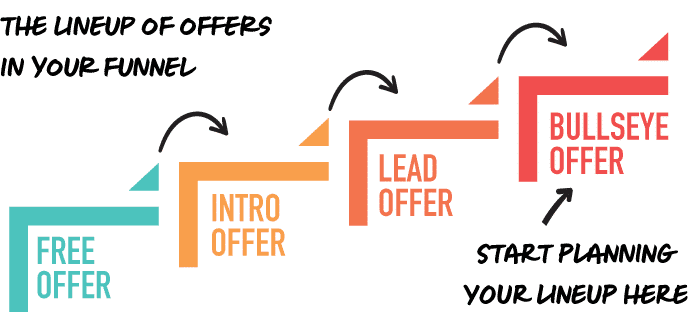
? Click the image below to grab our free Value Ladder Planner that goes into more detail about what to include.?
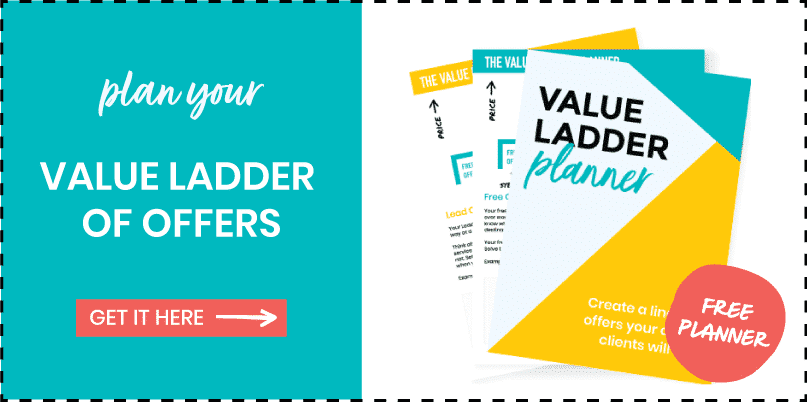
Now let’s put all of these ideas together and see how your funnel will look:
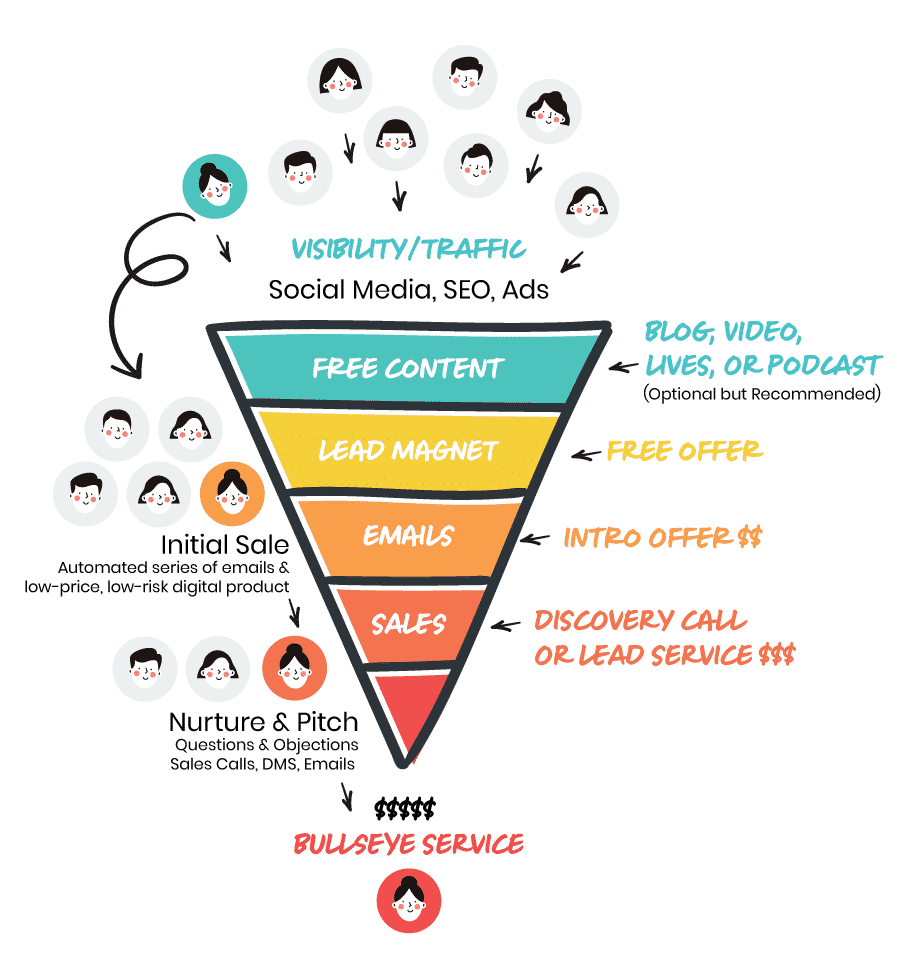
Traffic > Free offer > Intro Product > Lead Service > Bullseye!
While this may feel like a lot of things, chances are you already have at least some of these components already and others really don’t take that long to set up! You’ve got this. ?
Now let’s take a look at the components of your funnel….
9 Components Of An Ideal Service Business Sales Funnel
#1. Landing Pages
The standard service provider website usually consists of a home page, about page, services page, and contact.
The problem is, these pages typically have lots and lots of options for your website visitors to choose from and that can lead to “analysis paralysis” and that binary choice we talked about – “yes or no!” when most of your site visitors are “maybes.”
Your site visitors need to know EXACTLY what to do next if you want them to take action and if they’re not ready to hire you, they need a SMALL, low-risk step.
[Note: We’re not saying you shouldn’t have these common website pages – they’re especially useful for people who are super close to making a purchase and just have a few remaining questions and they need to know how to take the next steps to hire you.]
For your funnel, you want to start thinking about your website as a series of “landing pages” that you can link to from any content you create and social media (at the top of your funnel) and in your emails (the middle of your funnel).
A landing page is one page with one goal, that’s it. It makes it crystal clear what the visitor is supposed to do next (sign up, book a call, buy now, etc.)
#2. A Useful & Relevant “Lead Magnet” (Free Offer)
This should NOT be something that takes you a lot of time to create – it just needs to give your audience a “quick win” as it relates to your service offerings.
Think worksheet, 10 tips, a template, a cheat sheet, or a checklist.
(Check out Lead Magnet Mastery to learn how to create killer freebies that’ll get the right people into your funnel.)
#3. A Social Media “Home Base”
Figure out where your dream clients are most likely to be and focus on building your audience there – you don’t need to be everywhere, consistency is what matters. As you get the hang of that, you can branch out and master other channels.
❗Important: you’ll want to spend a % of your time promoting your free opt-in and getting people into your funnel. Don’t worry about being spammy! If you’re mixing it up with value posts you’re good. Remember that most of your audience will miss most of your messages most of the time.
#4. A Strategy to Drive Traffic to Your Landing Pages
OPTION 1: Free traffic – If your audience is on Pinterest, that’s a GREAT place to promote your freebies and get people into your funnel. If you have a blog, a YouTube channel or a podcast – always add a “call to action” that invites people to get your freebie and onto your mailing list. Plaster links to your opt-in landing pages everywhere and every chance you get.
OPTION 2: Paid traffic – You can also run ads to your freebies on Facebook, Instagram, LinkedIn, Pinterest, etc. — this is a good option for you especially if you don’t have time to create content.
(And of course, you can do both!)
⚠️ CAUTION: What you don’t want to do is just run ads to your website because as we’ve established, people won’t understand their next step and they’re likely to just click away without taking the action you want them to. But if you run ads to a landing page with a free offer or even a low cost digital product, you’ll be getting the right people into your funnels. Essentially, you’re paying for leads and if you have a low-cost product, that will help offset your advertising costs. And, you may even turn a profit! It took time, but we’ve transitioned completely from serving clients to just selling just digital products!
#5. An Email Service (Autoresponder)
You’ll need to set up automated nurturing email sequences you write in advance to deliver your freebie, introduce them to your digital product(s), and provide value so you can earn their trust.
After your audience has a chance to get to know you a little bit (we call this a “warm audience” – they’re warming up to you and the idea of purchasing from you), you can do a hard pitch to get them on a sales call or purchase your service package or program.
If you’re new to email marketing, MailerLite is a great place to start and is free for up to 1,000 subscribers.
#6. Automated Email Sequence(s)
Your email engagement is going to be highest when people first sign up (their problem is top of mind) so over the next 5-7 days after they sign up, you want to send out valuable emails that relate to their problem and the services you offer.
Then, once you’ve established the know, like, and trust factor with your super helpful emails – you’re ready to make your pitch!
This next step is a really powerful way to turn a member of your audience into a customer while they’re still in the research and consideration phases and that is to offer…
#7. A Low-Cost Digital Product (Optional but Recommended)
This is a GREAT way for you, as a service provider, to start creating passive income but it also helps you earn trust with people who are considering hiring you.
What you want to do here is relate it to the service you’re leading them to and help them solve the problem they have part of the way (in order to go further, they need to take the next step and hire you!).
If they find your product valuable, you’re establishing trust and staking your claim as a go-to expert. This step provides more value than your free offer but less than your done-for- or done-with-you services.
#8. A “Conversion Tool” (Optional but Recommended)
If you really want to create a banging funnel, you can add in a super valuable resource to really demonstrate your expertise and value.
These take more time to create than your “quick win” freebies so it’s perfectly okay to circle back around to this when you have time. But the idea here is, you’re giving them so much value they won’t even think about hiring your competition.
Examples include webinars, a free course, or a series of training videos.
❗IMPORTANT! When you’re just getting started, do NOT hold things up until you create a digital product or a conversion tool. Start with a simple funnel that includes a freebie and a series of emails. Then, add more to the funnel as you have time to work on these more robust components.
#9. A Pitch
By now, your audience has warmed up to you because you’ve been delivering value and it’s time to call them to action.
This could be to book a discovery call or to a purchase a lead service. (A lead service is essentially paid discovery but you’ll package it as a roadmap, success path, blueprint, etc. – a clear deliverable with standalone value.)
Let’s see how all of these components work together now!
Putting it All Together
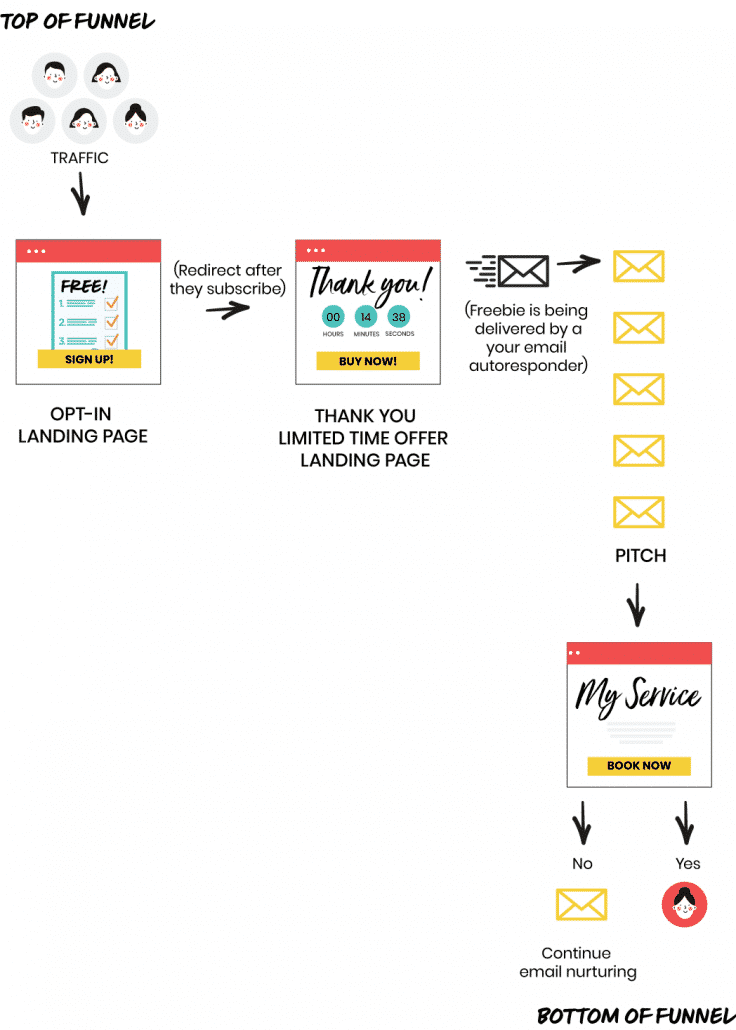
In Summary
When it’s all set up, your sales funnel will look like this:
>>> Traffic
>>> Opt-in landing page with a freebie
>>> Thank you page (you can offer your digital product here if you have one)
>>> Freebie delivery and nurturing email sequence
>>> Pitch
>>> Continue nurturing and optimizing your funnel as you have time
…that’s it! Set it and forget it!
Now you can focus on planning AHEAD rather than finding a client during a desperate famine phase. Whoo hoo! ?
Of course, there are many ways to go about this, but this is a great foundation funnel to put lead generation on autopilot… but really, this is just the start and the sky’s the limit from here. You can continue to add to your funnel by testing different freebies, layer on additional email sequences, offer additional products, add more “conversion tools,” etc.
You can test different things in your funnel too to get it converting even higher – things like adding urgency (special pricing for a limited time), exclusive subscriber bonuses, and so on.
The important thing is that you get started and there’s no time like RIGHT NOW to break that dreaded feast or famine cycle for good!
We hope this was helpful! Will you be setting up a funnel for your service business? Let us know in the comments below!


This post would work well as a mini-book or searchable PDF–it takes some study!
A simple strategy that impressed me many years ago was from Charlotte-Kennedy-Takahashi, first non-Japanese woman to start a (service) business in Japan (80s) the hugely successful Oak Associates. I’ve never forgotten her kernel of wisdom: “I spend 20% of my time planning for the future.” Mindset, methinks, mindset is the fulcrum.
Absolutely agree! That’s a great idea to turn it into a “to go” version Kay. I’m on it! 🙂
A simple strategy that impressed me many years ago was from Charlotte-Kennedy-Takahashi, first non-Japanese woman to start a (service) business in Japan (80s) the hugely successful Oak Associates. I’ve never forgotten her kernel of wisdom: “I spend 20% of my time planning for the future.” Mindset, methinks, mindset is the fulcrum.
Found a gem today! It opens up my mind on how to market my business.
Thank you so much for sharing!
So glad you found it helpful, Pooja!
Great article! This was very well done and extremely helpful. I appreciate your effort to write such worthy content.
funnel marketing expertk